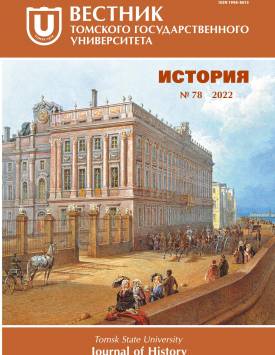Mechanisms of financial relations between the Imperial Cabinet and the estate of Siberian indigenous population during the age of the empire
Searching for models of establishing the financial relations between Russia and the territories newly incorporated into the imperial space had always occupied an important place in the domestic policy of the autocracy. On the eastern outskirts of Russia - in Siberia, this process was on the one hand inevitably associated with the comprehension of the newly incorporated lands and the local population fate within Russia, but primarily with determining the status of the incorporated region within the Empire, on the other. In the east of the country, the importance of the mentioned factors was reinforced by the importance of the "inorodic tribes" position in the advancement of the pioneer squads to the east and the consolidation of the Trans-Ural territories for the Russian state. In Russian Empire this process was accompanied by the spread of the Russian political, administrative, domestic and socio-cultural structure to the new territories, "pulling" the indigenous people into the national economic, political and socio-cultural system. In the case of the peoples of Siberia, the imperial formation process was initially accompanied by the imposition of tribute (yasak) on them in favor of the government. As the indigenous people became incorporated into the all-Russian system of state, economic, and other connections, they were subjected to other types of tax obligations, which differed little or nothing from the usual peasant burden. This circumstance fundamentally distinguished Russian colonization policy in Siberia from U.S. policy toward Indians, who did not pay taxes and, according to the U.S. Constitution, were not considered citizens of the state. The tribute policy was to help to maintain the new territories under the authority of the Russian tsar. Throughout the 17th and almost the whole 18th centuries, yasak evolved from tribute to taxation identical to that of peasants. From the middle of the 18th century, the yasak had become fully received by the Cabinet, but the dual nature of Siberian land ownership, when the co-owners of Siberian lands were the treasury and the imperial Cabinet, gave rise to the practice of mutual accounting of the treasury and the Cabinet on yasak case. It can be observed throughout the 19th and early 20th centuries. This contradiction was understandable to the tsarist dignitaries, who sought to legally secure the lands inhabited by the yasak people to the imperial Cabinet. The very existence of such projects testifies to the Cabinet's desire to completely subordinate the peoples of Siberia to its influence and to the ingrained habit of officials of the Ministry of the Imperial Court to emphasize the peculiarity of the crown estates and their difference from the state ones. In Russia, yasak was the most territorially widespread kind of tax. By the eve of 1917, it was paid by all the nomadic peoples of Tobolsk, Tomsk, Yenisei, Irkutsk provinces, Transbaikal and Yakutsk regions, and also a part of the population of Arkhangelsk and Perm provinces. It had much in common with the taxation duties of the other colonized outskirts of the Romanov Empire. The authors declare no conflicts of interests.
Keywords
Siberia, inorodtsy (indigenous population), treasury, the Cabinet, yasakAuthors
| Name | Organization | |
| Dameshek Lev M. | Irkutsk State University | levdameshek@gmail.com |
| Dameshek Irina L. | Irkutsk State University | dameshek@rambler.ru |
References

Mechanisms of financial relations between the Imperial Cabinet and the estate of Siberian indigenous population during the age of the empire | Tomsk State University Journal of History. 2022. № 78. DOI: 10.17223/19988613/78/3
